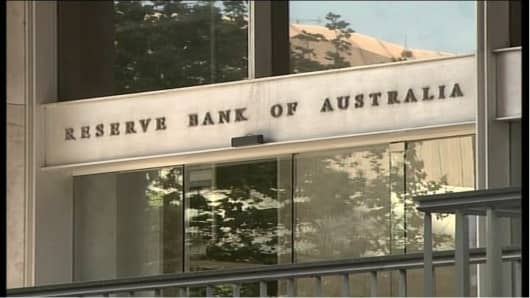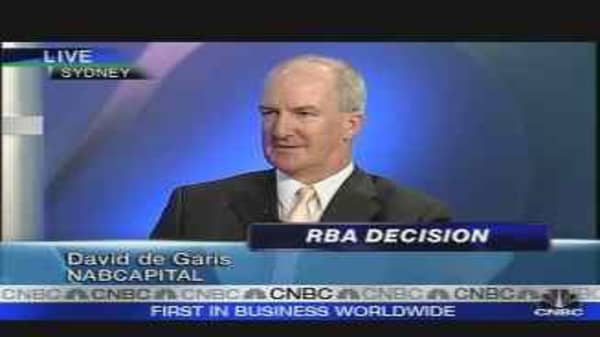Australia's central bank left interest rates unchanged on Tuesday and said previous increases were working to moderate inflation pressures, perhaps an indication that it might not need to tighten again.
In a brief statement following its monthly policy meeting, the Reserve Bank of Australia (RBA) said it was leaving its benchmark cash rate unchanged, having lifted it to a 12-year high of 7.25 percent just the month before.
The move was widely expected given recent signs of softness in consumer and business sentiment and a deepening global credit squeeze. Investors seized on the mention of moderating demand to justify bets against a further tightening.
"It certainly looks more balanced than previous statements. We had been expecting a hike in May, but it now looks more likely that they'll be on hold," said Stephen Halmarick, co-head of markets at Citi.
The local dollar slipped a quarter of a U.S. cent and bill and bond futures firmed after the statement.
The steady decision was welcomed by Treasurer Wayne Swan, given rising borrowing costs are a touchy topic in a country where household debt is at record highs.
"Today's Reserve decision is a welcome reprieve for working families who've been doing it tough," Swan told reporters.
The central bank noted that the four rate rises since August, combined with further increases in borrowing costs by commercial banks because of the credit crunch, had led to a substantial tightening in financial conditions.
"That is working to foster the moderation in demand growth that will take pressure off inflation," wrote RBA Governor Glenn Stevens in Tuesday's statement.
Annual underlying inflation accelerated to a 16-year high of 3.6 percent in the fourth quarter of last year, well above the central bank's 2 percent to 3 percent comfort zone.
"In the short term, inflation is likely to remain relatively high. However, inflation should decline over time, provided demand slows as expected," said Stevens.
Wait And See
Inflation data for the first quarter are due out on April 23 and are expected to show a further pick-up in price pressures, driven by petrol, food, rents and financial costs.
"The RBA's basic position is that it is going to take an awful lot to make them shift policy," said Stephen Roberts, a research director at Lehman Brothers.
"From here they will watch for longer-term developments on domestic spending and inflation," he added. "If that works as they expect, they will bring interest rates down, but that's a long way down the track."
Indeed, investors are already betting the next move in rates will be down with no less than half a percentage point of cuts priced in for the next 12 months.
Yet a Reuters poll of 22 economists taken last week showed 13 felt rates could rise again in May as coming inflation figures were likely to show another alarming shift higher.
"We've still got a hike forecast for May based on the outlook for a high inflation number," said Michael Blythe, chief economist at Commonwealth Bank.
He noted the economy was still set to get a boost from huge price rises in some of Australia's major commodity exports, notably iron ore and coal. And there were record tax cuts to be delivered from mid-year on.
"There's opposing forces at work between inflation and the global background and we'll just have to see how things play out in the next month or so," concluded Blythe.




